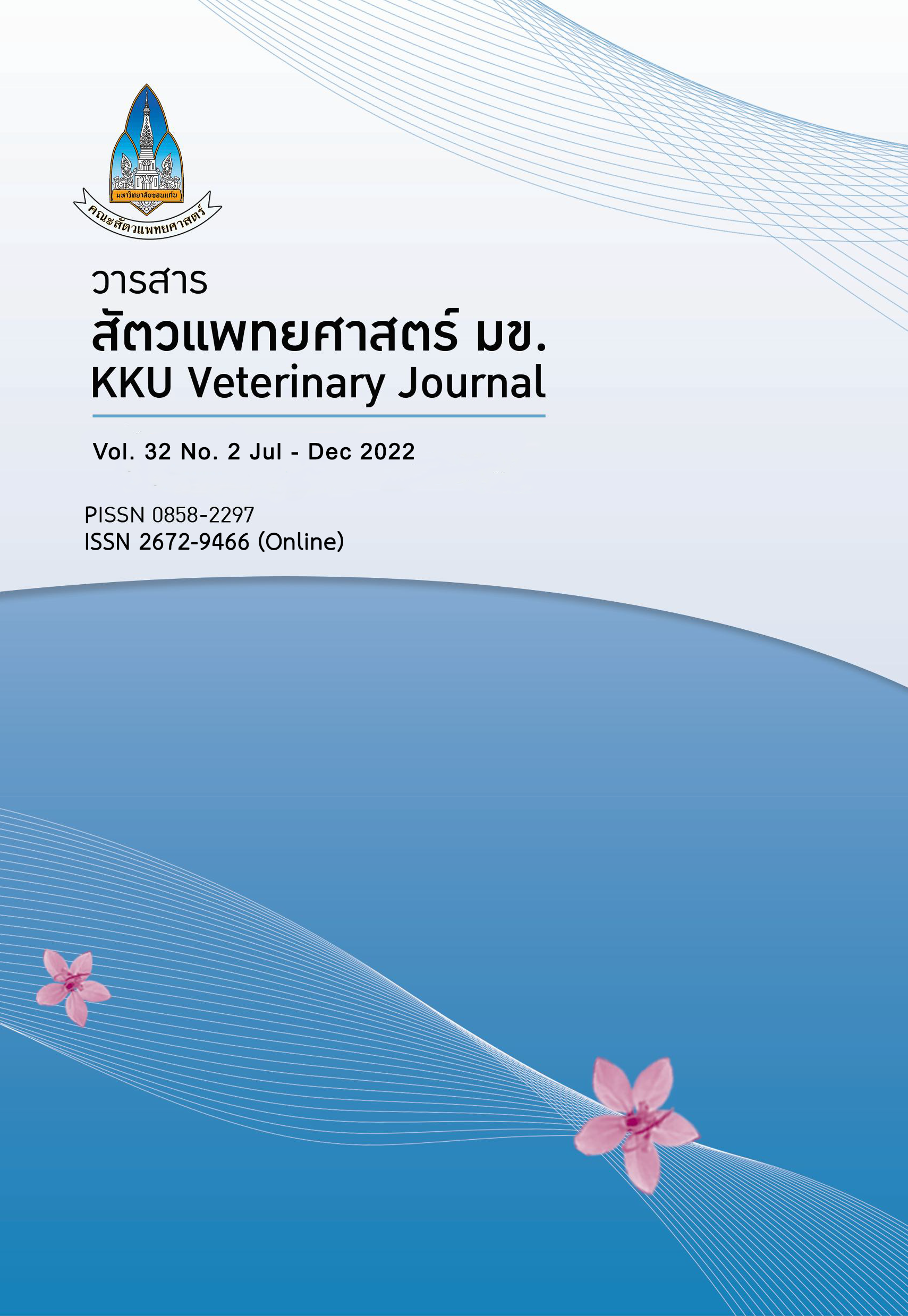การวัดอารมณ์โดยวิธีทดสอบอารมณ์ในซองบังคับและการวัดความเร็วออกจากซองบังคับในโคเนื้อ
Main Article Content
บทคัดย่อ
วัตถุประสงค์ การศึกษาครั้งนี้มีวัตถุประสงค์เพื่อศึกษาพฤติกรรมและสภาวะอารมณ์ของโคเนื้อโดยการจัดจำแนกกลุ่มอารมณ์โคเป็นกลุ่มอารมณ์สงบและอารมณ์รุนแรง โดยการใช้เทคนิคการทดสอบอารมณ์ในซองบังคับ (Chute test) และการวัดความเร็วออกจากซองบังคับ (Exit velocity test)
วัสดุ อุปกรณ์ และวิธีการ การทดลองนี้ศึกษาในโคเนื้อเพศเมียพันธุ์กำแพงแสนจำนวน 28 ตัว อุปกรณ์สำหรับการทดลองประกอบด้วย กล้องบันทึกภาพและวีดีโอ คอมพิวเตอร์โน๊ตบุ๊ค ซองทดสอบอารมณ์ และซองวัดความเร็วออกจากซองบังคับ ทดสอบอารมณ์โคโดยวิธีทดสอบอารมณ์ในซองบังคับและการวัดความเร็วออกจากซองบังคับโดยทดสอบอารมณ์ทั้งหมด 4 ครั้งและนำค่าที่ได้จากการทดสอบมาจัดกลุ่มอารมณ์อารมณ์สงบและอารมณ์รุนแรง
ผลการศึกษา ผลการทดสอบอารมณ์โคโดยวิธีทดสอบอารมณ์ในซองบังคับและการวัดความเร็วออกจากซองบังคับ พบว่าคะแนนอารมณ์ระดับต่ำและสูงมีค่าเฉลี่ยเท่ากับ 1.94±0.23 และ 3.46±0.60 ตามลำดับ ความเร็วออกจากซองบังคับช้าและเร็วมีค่าเฉลี่ยเท่ากับ 0.24±0.04 m/s และ 0.46±0.17 m/s ตามลำดับ นำผลการทดสอบอารมณ์ในซองบังคับและค่าความเร็วออกจากซองบังคับมาจัดจำแนกกลุ่มโคที่มีอารมณ์สงบและโคที่มีอารมณ์รุนแรง จากการแบ่งกลุ่มอารมณ์พบว่า กลุ่มโคอารมณ์สงบ (n=13) และกลุ่มโคอารมณ์รุนแรง (n=15) และทดสอบความสัมพันธ์ระหว่างคะแนนอารมณ์และค่าความเร็วออกจากซองบังคับพบว่าค่าดังกล่าวมีค่าบวก (r=0.87; P< 0.01)
สรุป การนำเทคนิคการทดสอบอารมณ์ในซองบังคับและการวัดความเร็วออกจากซองบังคับมาใช้ในการประเมินอารมณ์โคร่วมกันจะช่วยเพิ่มประสิทธิภาพในการทดสอบและวัดอารมณ์โคในการจัดกลุ่มโคที่มีอารมณ์สงบและรุนแรงได้ สามารถทำได้โดยการทดสอบอารมณ์ในซองบังคับ (Chute test) และการวัดความเร็วออกจากซองบังคับ (Exit velocity) ซึ่งสามารถจำแนกอารมณ์โคในสภาพการเลี้ยงแบบฟาร์มได้ และนอกจากนี้ควรได้รับการศึกษาต่อไปถึงผลของอารมณ์ที่แสดงออกผ่านพฤติกรรมการศึกษาความผันแปรของพฤติกรรม ระดับอารมณ์ และการพัฒนาวิธีการทดสอบอารมณ์ในระบบการผลิต ที่น่าจะเป็นประโยชน์ในการปรับปรุงประสิทธิภาพในการผลิตโคในอนาคต เช่น การคัดเลือกสายพันธุ์สัตว์ที่มีอารมณ์สงบ การให้ผลผลิตของเนื้อที่แตกต่างกันของโคกลุ่มอารมณ์สงบและอารมณ์รุนแรง เป็นต้น
Article Details

อนุญาตภายใต้เงื่อนไข Creative Commons Attribution-NonCommercial-NoDerivatives 4.0 International License.
เอกสารอ้างอิง
Albright JL, Arave CW, 1997. The behavior of cattle. CAB International New York NY 306.
Bennett SL, 2010. Temperament tests: What we do and do not know about them. Appl Anim Behav Sci 106, 85-95.
Broom DM, Fraser AF, 2015. Domestic animal behaviour and welfare 5th ed. Wallingford CABI 472.
Bruno KA, Vanzant ES, Vanzant KA, McLeod KR, 2016. Relationships of a novel objective chute score and exit velocity with growth performance of receiving cattle. J Appl Anim Sci 94, 4819-4831.
Burrow HM, Dillon RD, 1997. Relationships between temperament and growth in a feedlot and commercial carcass traits of Bos indicus
crossbreds. Aust J Exp Agric 37, 407- 411.
Burrow HM, Seifert GW, Corbet NJ, 1988. A new technique for measuring temperament in cattle. Proceedings of the Australian Society of Animal Production 17, 154-157.
Cafe LM, Robinson DL, Ferguson DM, McIntyre BL, Geesink GH, Greenwood PL, 2011. Cattle temperament persistence of assessments
and associations with productivity efficiency carcass and meat quality traits. J Appl Anim Sci 89, 1452-1465.
Curley KO, Paschal JRJC, Welsh TH, Randel RD, 2006. Technical note: Exit velocity as a measure of cattle temperament is repeatable and
associated with serum concentration of cortisol in brahman bulls. J Appl Anim Sci 84, 31-38.
Enriquez D, Hotzel MJ, Ungerfeld R, 2011. Minimising the stress of weaning of beef. Acta Vet Scand 53, 28-34.
Francisco CL, Cooke RF, Marques RS, Mills RR, Bohnert DW, 2012. Effects of temperament and acclimation to handling on feedlot
performance of bos taurus feeder cattle originated from a rangeland-based cow-calf system. J Appl Anim Sci 90, 5067-5077.
Grandin T, 1993. Behavioral agitation during handling of cattle is persistent over time. Appl Anim Behav Sci 36, 1-9.
Grandin T, Shivley C, 2015. How farm animals react and perceive stressful situations such as handling, restraint, and transport. Animals 5, 1233-1251.
Mitlohner FM, Galyean ML, McGlone JJ, 2002. Shade effects on performance, carcass traits, physiology, and behavior of heat-stressed
feedlot heifers. J Appl Anim Sci 80, 2043-2050.
Parham JT, Tanner AE, Barkley K, Pullen L, Wahlberg ML, Swecker WS, Lewis RM, 2019. Temperamental cattle acclimate more
substantially to repeated handling. Appl Anim Behav Sci 212, 36-43.
SAS, 2014. University-edition, sas institute inc, cary, north carolina.
Wyatt WE, DeRouen SM, Franke DE, Blouin DC, 2013. Effects of temperament on growth and reproductive performance in heifers. Professional Animal Scientist 29, 490-500.


